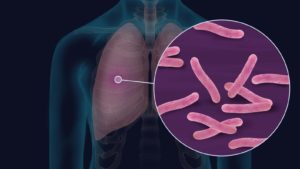Tuberculosis Exposure Meeting Kit

Tuberculosis (TB) is an infectious disease caused by bacteria Mycobacterium tuberculosis (M. tuberculosis). It typically affects the lungs, but may also affect other parts of the body such as the kidneys, bones, or the brain. TB can spread by infected people who release the bacteria into the air on tiny, invisible droplets by coughing, laughing, sneezing, or speaking. It can spread by infected tissue during autopsy, mortuary operations, and certain laboratory work. Because it can be fatal, diagnosis and treatment of TB is not only important for personal health, it’s also important for preventing the spread of TB.
TRANSMISSION OF TUBERCULOSIS
When a person with active TB coughs, sneezes, talks, or spits, tiny droplets containing the bacteria are released into the air and can be inhaled by people who are close by. The bacteria can spread from the initial location in the lungs to other parts of the body through the bloodstream. Only a small number of bacteria are needed to cause an infection.
Persons with latent TB infection cannot transmit TB because bacteria are not present in their saliva or sputum.
SIGNS AND SYMPTOMS OF TUBERCULOSIS
The signs or symptoms of active TB infection include:
- Cough that lasts 3 weeks or longer
- Presence of blood or sputum in cough
- Pain in chest
- Loss of weight
- Loss of energy
- Poor appetite
- Fever, chills, night sweats
TUBERCULOSIS TREATMENT
TB can be treated effectively with a combination of drugs. It is important to follow the doctor’s directions and take the drugs exactly as recommended. If you forget to take your pills, or if you only take some of them, the tuberculosis bacteria may become resistant to the drugs (forming a drug-resistant TB strain).
HIGH RISK EMPLOYEES
Most people infected with TB will never develop active TB disease because the body’s immune system keeps the bacteria under control and inactive. Certain work situations are at higher risk for exposure as:
- Clinics
- Hospitals
- Nursing homes
- Correctional facilities
- Homeless shelters
- Drug treatment centers
- Home-based healthcare
- Emergency medical transportation and service providers
EMPLOYEES EXPOSED TO TB
TB Testing and Diagnosis
The only way to know if an employee has TB is for them to get a TB skin test. A skin test will show if the M. tuberculosis bacteria is in the body. During the test, a healthcare professional places a small amount of solution under the skin with a needle to see if a reaction occurs. Within 2-3 days after the test, a healthcare professional will measure the reaction area and evaluate the skin test results. In some cases, a second test may be needed to confirm results.
A “positive” TB skin test result means the person tested may have been infected with the M. tuberculosis bacteria and may have either TB infection or TB disease. Additional tests such as chest x-rays and sputum analysis can determine whether the infection is latent or active. After evaluating test results, a healthcare professional will advise appropriate treatment.
If an employee is diagnosed with TB, the supervisor should ensure that the employee does not return to work until cleared to do so by a healthcare professional. Coworkers may need to be notified as well.
LATENT TB INFECTION TREATMENT
TB will not go away on its own. To prevent latent infections from becoming active, treatment is indicated for most cases. Prescribed medication usually cures TB, but only if all medication is taken and all instructions are followed—even after symptoms have stopped. This usually keeps the infection from developing into the disease. If anyone stops medication before using the full prescription, they could develop a form of TB that is resistant to subsequent medication and is harder to cure (drug-resistant TB).
IS TUBERCULOSIS AN OCCUPATIONAL ISSUE?
In the workplace, employees can contract TB directly from actively infected persons or from breathing in air that contains the bacteria. While the risk of workers contracting TB is higher in health care and in prisons where people with TB may be treated or detained, all workplaces should be aware of how TB can spread.
A TB control program should include policies and procedures for:
- rapid identification, isolation, and treatment of individuals with infectious TB or those suspected of being infected,
- appropriate controls such as establishment of negative-pressure isolation rooms and a respiratory protection program, and
- adoption of routine practices and additional precautions by staff.
In a health care setting, infectious individuals should be placed in private rooms. The isolation room must be at negative air pressure, and it must have adequate ventilation to dilute the concentration of contaminants within the room. The air from the isolation room must be directly exhausted to the outside.
FINAL WORD
People who work in high-risk occupations have to be continually on their guard to avoid exposure to TB infection. But the general public must also stay vigilant and not be lulled in a fog when it comes to preventing exposure.